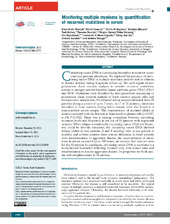| dc.contributor.author | Rustad, Even Holth | en_US |
| dc.contributor.author | Coward, Eivind | en_US |
| dc.contributor.author | Skytøen, Emilie R | en_US |
| dc.contributor.author | Misund, Kristine | en_US |
| dc.contributor.author | Holien, Toril | en_US |
| dc.contributor.author | Standal, Therese | en_US |
| dc.contributor.author | Børset, Magne | en_US |
| dc.contributor.author | Beisvag, Vidar | en_US |
| dc.contributor.author | Myklebost, Ola | en_US |
| dc.contributor.author | Meza, Leonardo Zepeda | en_US |
| dc.contributor.author | Hong, Yan Dai | en_US |
| dc.contributor.author | Sundan, Anders | en_US |
| dc.contributor.author | Waage, Anders | en_US |
| dc.date.accessioned | 2018-04-24T12:12:00Z | |
| dc.date.available | 2018-04-24T12:12:00Z | |
| dc.date.issued | 2017 | |
| dc.Published | Rustad EH, Coward E, Skytøen ER, Misund K, Holien T, Standal T, Børset MB, Beisvag V, Myklebost O, Meza ZL, Hong HYD, Sundan A, Waage A. Monitoring multiple myeloma by quantification of recurrent mutations in serum. Haematologica. 2017;102(7):1266-1272 | eng |
| dc.identifier.issn | 0390-6078 | |
| dc.identifier.issn | 1592-8721 | |
| dc.identifier.uri | https://hdl.handle.net/1956/17648 | |
| dc.description.abstract | Circulating tumor DNA is a promising biomarker to monitor tumor load and genome alterations. We explored the presence of circulating tumor DNA in multiple myeloma patients and its relation to disease activity during long-term follow-up. We used digital droplet polymerase chain reaction analysis to monitor recurrent mutations, mainly in mitogen activated protein kinase pathway genes NRAS, KRAS and BRAF. Mutations were identified by next-generation sequencing or polymerase chain reaction analysis of bone marrow plasma cells, and their presence analyzed in 251 archived serum samples obtained from 20 patients during a period of up to 7 years. In 17 of 18 patients, mutations identified in bone marrow during active disease were also found in a time-matched serum sample. The concentration of mutated alleles in serum correlated with the fraction in bone marrow plasma cells (r=0.507, n=34, P<0.002). There was a striking covariation between circulating mutation levels and M protein in ten out of 11 patients with sequential samples. When relapse evaluation by circulating tumor DNA and M protein could be directly compared, the circulating tumor DNA showed relapse earlier in two patients (3 and 9 months), later in one patient (4 months) and in three patients there was no difference. In three patients with transformation to aggressive disease, the concentrations of mutations in serum increased up to 400 times, an increase that was not seen for the M protein. In conclusion, circulating tumor DNA in myeloma is a multi-faceted biomarker reflecting mutated cells, total tumor mass and transformation to a more aggressive disease. Its properties are both similar and complementary to M protein. | en_US |
| dc.language.iso | eng | eng |
| dc.publisher | Ferrata Storti Foundation | eng |
| dc.rights | Attribution CC BY-NC | eng |
| dc.rights.uri | http://creativecommons.org/licenses/by-nc/4.0/ | eng |
| dc.title | Monitoring multiple myeloma by quantification of recurrent mutations in serum | en_US |
| dc.type | Peer reviewed | |
| dc.type | Journal article | |
| dc.date.updated | 2017-12-29T11:30:31Z | |
| dc.description.version | publishedVersion | en_US |
| dc.rights.holder | Copyright 2017 Ferrata Storti Foundation | |
| dc.identifier.doi | https://doi.org/10.3324/haematol.2016.160564 | |
| dc.identifier.cristin | 1482849 | |
| dc.source.journal | Haematologica | |
| dc.relation.project | Norges forskningsråd: 218241 | |
| dc.relation.project | Norges forskningsråd: 221580 | |

